For every football fan, there is something extra special about seeing an academy prospect make waves in a first-team setting. We’ve had some young players make that step up in the Premier League recently – Chelsea’s Levi Colwill is an excellent example of this. The now 20-year-old centre-back came through the ranks at Chelsea before making a somewhat seamless step into Premier League football. Meanwhile, Liverpool’s need for a new central defender was lessened thanks to the presence of Jarell Quansah, with other youngsters at Anfield starting to make a good impression in competitions like the League Cup and the UEFA Europa League.
Frankly, we could list plenty of other young players who have made the step up from youth football in the Premier League this season, but we’d be here all day. Instead, this data analysis will uncover some of the top talents in the Premier League 2 (U21 Premier League) based on data and statistics from the 2023/24 campaign so far. The analysis will look at a variety of stats to see which goalkeepers, defenders, midfielders, and forwards have been performing strongly this season.
While there are no strict limitations or criteria for selection in this data analysis, all data included is based on appearances in the Premier League 2 only. For each segment (GKs, Defenders, WB/FBs), we will be using one top 10 ranking metric as a foundation to collect the group of 10 players involved in each segment of analysis. The foundation metric will be highlighted in each segment.
Goalkeepers
It is arguably more difficult for a goalkeeper to break into first-team football in the Premier League for various reasons. One of the main ones being that most clubs prefer an experienced, established figure between the sticks, but this isn’t to say that young keepers don’t get a chance, full stop. Perhaps the highest profile young keeper is Burnley stopper James Trafford. The Manchester City academy graduate enjoyed a couple of loan spells in the EFL, most recently playing in League One last season with Bolton Wanderers. During this time, he impressed many, with Vincent Kompany being impressed enough to splash out a reported £19m for his services. At 21 years of age, Trafford is already an EPL regular with a big future ahead of him. This first segment of analysis looks to see which keepers could follow in his footsteps.
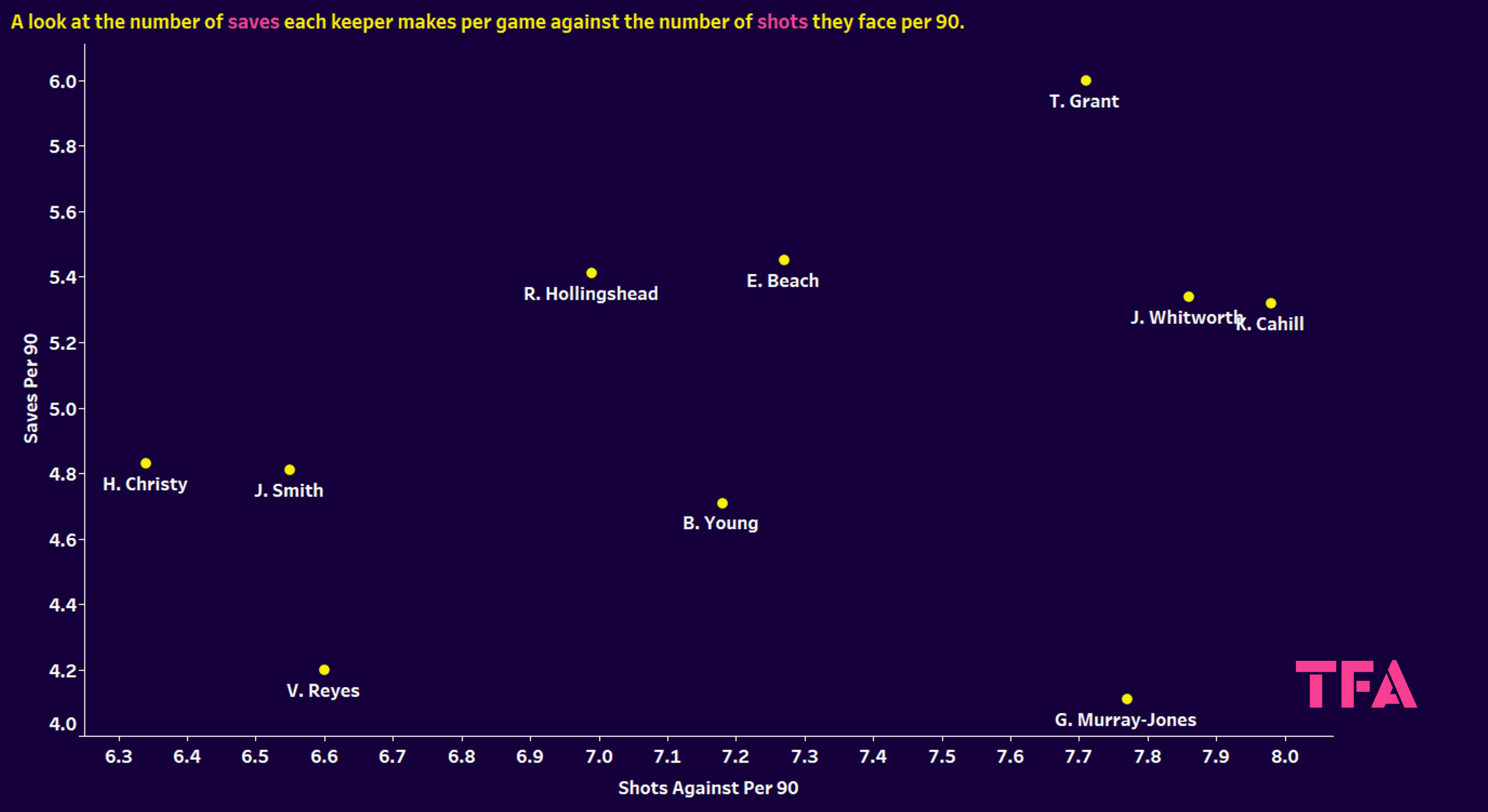
We have selected 10 goalkeepers for this data analysis, picked from the names in the current top 10 ranking for saves per 90 in the PL2, according to Wyscout. We used the same 10 players for the other included metrics in the analysis. This method of player selection is consistent throughout the data analysis when it comes to discussing defenders. Unfortunately, due to an apparent lack of consistent data from Wyscout in other metrics, we can’t analyse GK metrics such as save rate % and various passing metrics.
A couple of names immediately stand out, one of them being True Grant, Manchester City’s 18 Y/O keeper who is having quite the season so far. At the time of writing, he averages six saves per 90 while facing 7.11 shots per 90, indicating a good consistency in his shot-stopping ability. By contrast, his City teammate George Murray-Jones faces a similar frequency of shots (7.77) but offers a lower save rate, making 4.11 per 90. That statistic isn’t to be frowned upon, though, as Murray-Jones still ranks in the top 10 for saves per 90. Of course, the likelihood of either of these keepers breaking through in Guardiola’s team is currently very low – a loan move to an EFL club could be the road to go down to get themselves noticed on a first-team basis.
Away from City, there are four other keepers worth mentioning, as they all average above five saves per 90. Eddie Beach of Chelsea offers the most saves per 90 (5.45) of that group of four GKs, with West Bromwich Albion keeper Ronnie Hollingshead offering similar numbers. Brighton & Hove Albion’s Killian Cahill and Crystal Palace’s Joe Whitworth also offer positive data while facing a high number of shots per 90.

Looking closer at each keeper’s performance, we move on to discuss their prevented goals per 90, which gives us more context to the saves they make. Without going down a rabbit whole of different areas of prevented goals, at its surface, this metric is measured by subtracting the number of goals a GK has conceded from the number of goals they would be expected to concede based on shot quality (xGOT – expected goals on target model). In essence, prevented goals is to a goalkeeper what xG is to a striker.
Leading the way by some margin again is True Grant, with Beach and Hollingshead offering good numbers, too. Leeds United keeper Harry Christy puts himself in good stead, too, thanks to his 0.21 prevent goals per 90.
A few keepers on the list offer a negative number in prevented goals per 90, with Murray-Jones offering -0.49 per 90; Cahill with -0.43. This is an indicator of a need to improve their ability to save higher-quality shots on a more consistent basis.
Outside of the 10 keepers involved in this analysis, other names pop up in the top 10 rankings for prevented goals. Players such as Sunderland’s Matthew Young (0.39), Arsenal’s Ovie Ejeheri (0.33), and Tottenham Hotspur’s Josh Keeley (0.2) all show promise in this area.
Defenders – the meat and potatoes of being a reliable defender
As mentioned in the intro, Quansah and Colwill are just two examples of young players breaking into the first team of their respective clubs. The reason they’ve impressed is their ability to build on the strong start they displayed when called upon, resulting in them remaining fresh in the managers’ thoughts throughout the course of the season so far. Which defenders could follow them? This segment looks at the defensive performance of CBs and FB/WBs – selected based on the top 10 rankings for defensive duels won %.
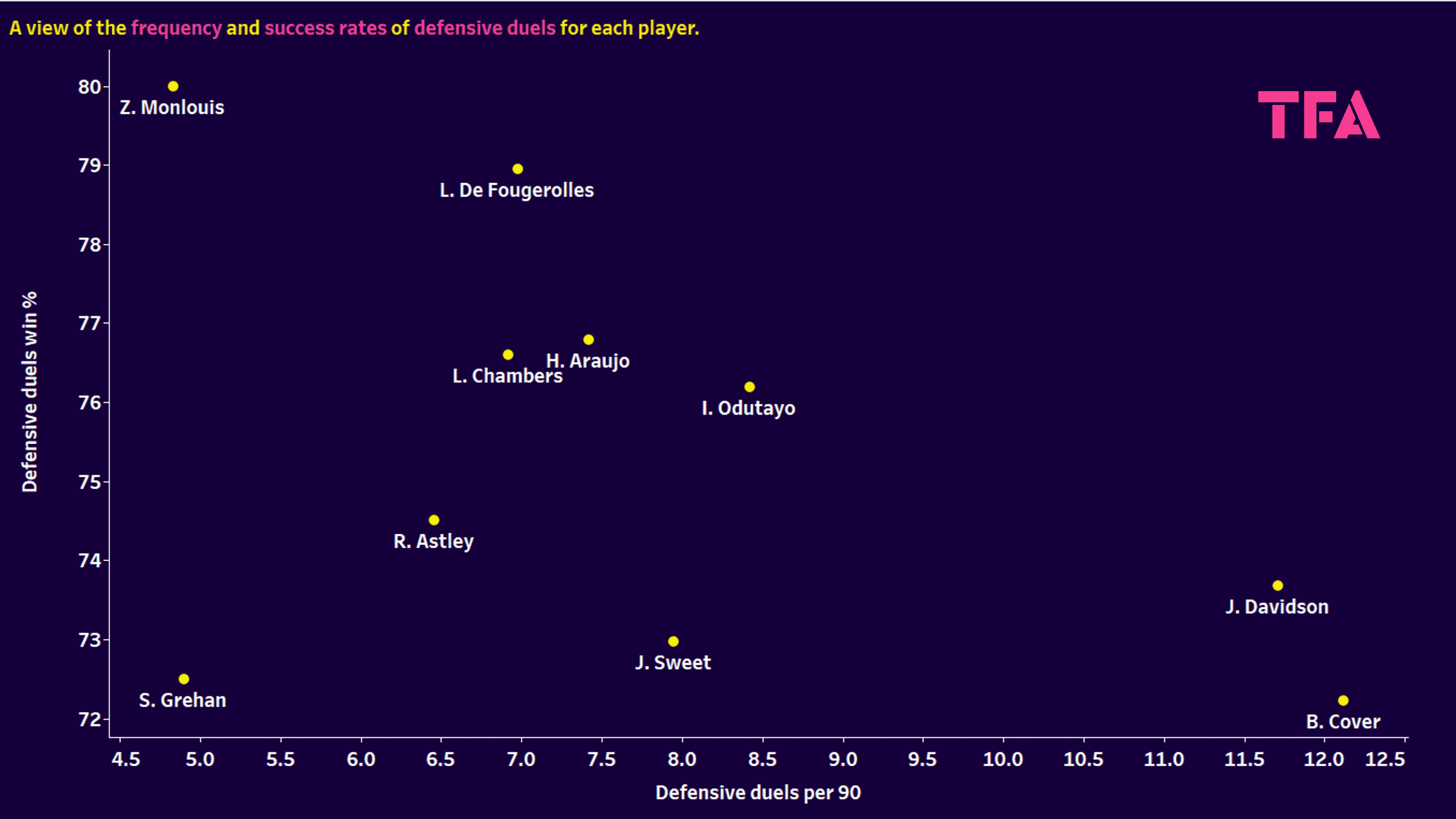
We start by looking at one of the key statistics for a defender, analysing their ability to engage in and be successful defensive duels. There is a balance to be struck when it comes to putting yourself in for a tackle: having a high engagement with mediocre (or less) success can be dangerous for the team, as you can find yourself out of position if unsuccessful in a duel. On the other hand, however, not engaging enough in defensive duels — adopting a more passive approach, will raise questions about your bravery, determination, and overall defensive ability.
It is also essential to consider that, as this group of 10 defenders was selected due to their high success rates in defensive duels, even the players toward the bottom end of the chart have been performing to a good level of consistency.
Liverpool right-back Josh Davidson and Leicester City’s Brandon Cover (who can also play in midfield) both have high engagement rates for defensive duels. While, as mentioned, they are still performing to a reasonable level, they find themselves with lower success rates than a cluster of other names.
Arsenal’s Zane Monlouis offers the highest success rate in the EPL2, indicating strength in his skillset – he does not offer a high engagement, though, making 4.83 per 90 – the lowest in this group. Perhaps the best pound-for-pound defender in this metric & group is Fulham’s Luc De Fougerolles, who offers both a strong engagement (6.98 per 90) and a fantastic success rate (78.95%).

Another important defensive factor is the ability to read situations and break up opposition play. To gain an insight into the selected defenders’ performance in these areas, we will discuss the number of interceptions and ball recoveries they make per 90.
Brandon Cover is one player who excels at both metrics, making 5.84 interceptions per 90 and 9.88 recoveries per 90 – definitely playing a part in his midfield ability as well. We may see Cover make the step up to Leicester’s first team this season for the odd appearance; meanwhile, a loan to an EFL club next season could be a wise decision, especially if the Foxes are promoted to the Premier League.
Crystal Palace defender Sean Grehan, who has recently joined League One Carlisle United, offers the best rate in both metrics in comparison to the nine defenders in this analysis. These high numbers suggest a real tenacity and aggression that he channels well into stopping play and regaining the ball, qualities that he will have to utilise well in the third tier.
When considering defenders that aren’t involved in this group, there are some names that impress in terms of interceptions – Leicester’s Ben Nelson, who has had a previous loan spell at Doncaster Rovers before this season, averages an incredible 9.18 interceptions per 90 – his skillset is one that, with more game experience, could be very valuable in the EFL. There are a cluster of names that average more interceptions than players in this group.
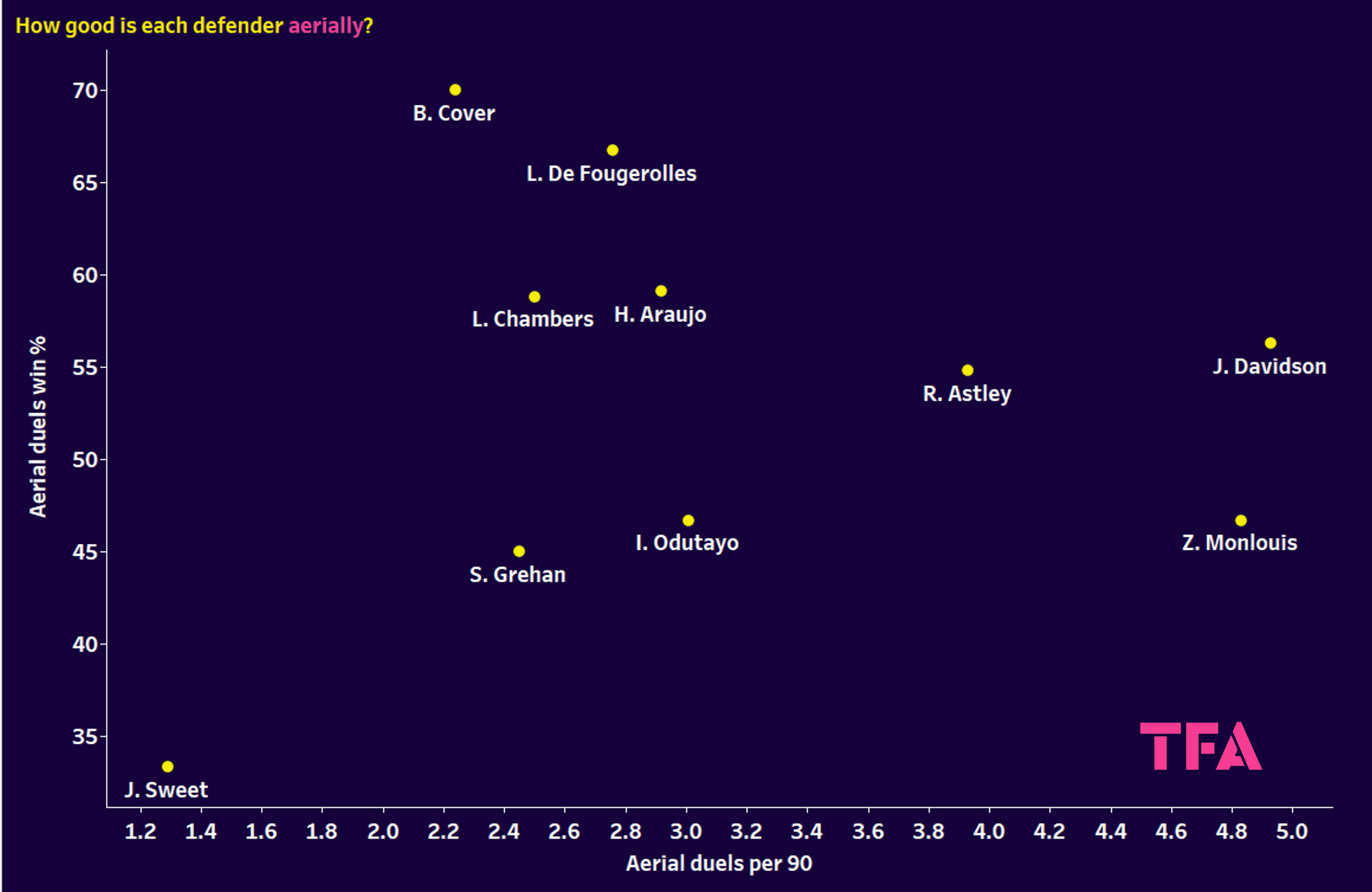
Being aerially reliable is, for obvious reasons, a desirable trait that high-level clubs often look for in defenders. Of course, some of the players involved here are full-backs, who, generally speaking, can often be shorter than CBs and get involved in fewer aerial duels.
Cover puts himself in a good light again thanks to his high success rate in the air, winning 70% of his aerial duels. However, he does contribute a lower engagement rate in the air. Fougerolles seems to be good at striking the aforementioned balance between engagement and success – he attempts 2.76 aerial duels per 90 with a success rate of 66.7%, indicating an excellent aerial ability from the defender who can play anywhere across the back line. He is only 5 foot 9, which makes his aerial success rates even more impressive.

Although the idea behind this segment of data analysis was to see which defenders are performing well in a purely defensive aspect, we will touch on an in-possession aspect, too. While we could divulge every passing metric under the sun, the aim of including this graph was to get a foundational idea of reliability on the ball.
Four players lead the way for pass accuracy compared to the other six in this group – Monlouis’s accuracy rate of 93.9% is the highest of the group, a credit to Arsenal’s academy moulding players to fit their tactics on a first-team basis. De Fougerolles ranks high once again, as does Everton’s Ryan Astley and Fulham’s Idris Odutayo, with all four players boasting a pass accuracy of over 90%.
Full-backs and wing-backs – the attacking side of a defender’s role
Not that wing-backs and full-backs never used to be essential roles, but modern football seems to require a higher all-round standard of play due to the demands of the role in line with specific tactics. Some full/wing-backs were included in the data analysis of defensive metrics, but this segment looks at WB/FBs exclusively to highlight which wide defenders offer a high quality in attack. For this selection of players, we picked the top 10 players ranked for crosses per 90 in the EPL2, as consistently offering deliveries from wide areas was indicates a high attacking engagement. This metric was also the most reliable in terms of being able to pick the top 10 players.
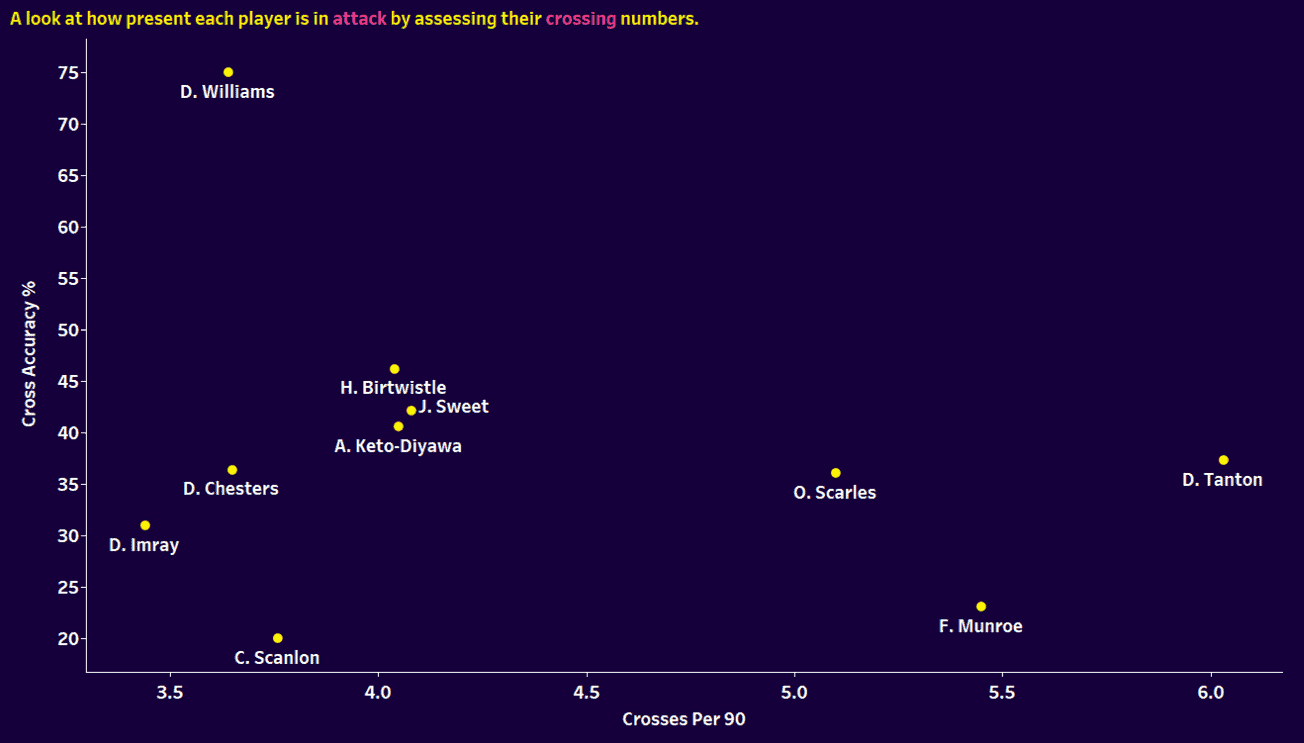
We’ll start by discussing the players with high crossing rates, as that metric provided the list of players. American right-back Devan Tanton, currently a member of Fulham’s U21 squad, offers more crosses than any other FB/WB in the league, putting 6.03 deliveries in per 90 – his accuracy of 37.3% is around the midway point of this group, indicating an excellent pound-for-pound set of stats that suggest an ability in crossing. Aston Villa LB Finley Munroe (5.45 per 90) and West Ham’s Oliver Scarles (5.1 per 90) both average many crosses, with Scarles having the higher accuracy rate.
Chelsea LB Dylan Williams has a low cross rate in the context of this group, but in comparison to the league, it is still fairly high – Williams does offer a high accuracy, higher than anyone else in this group, indicating a strong crossing ability that could be a significant asset in his future play style.
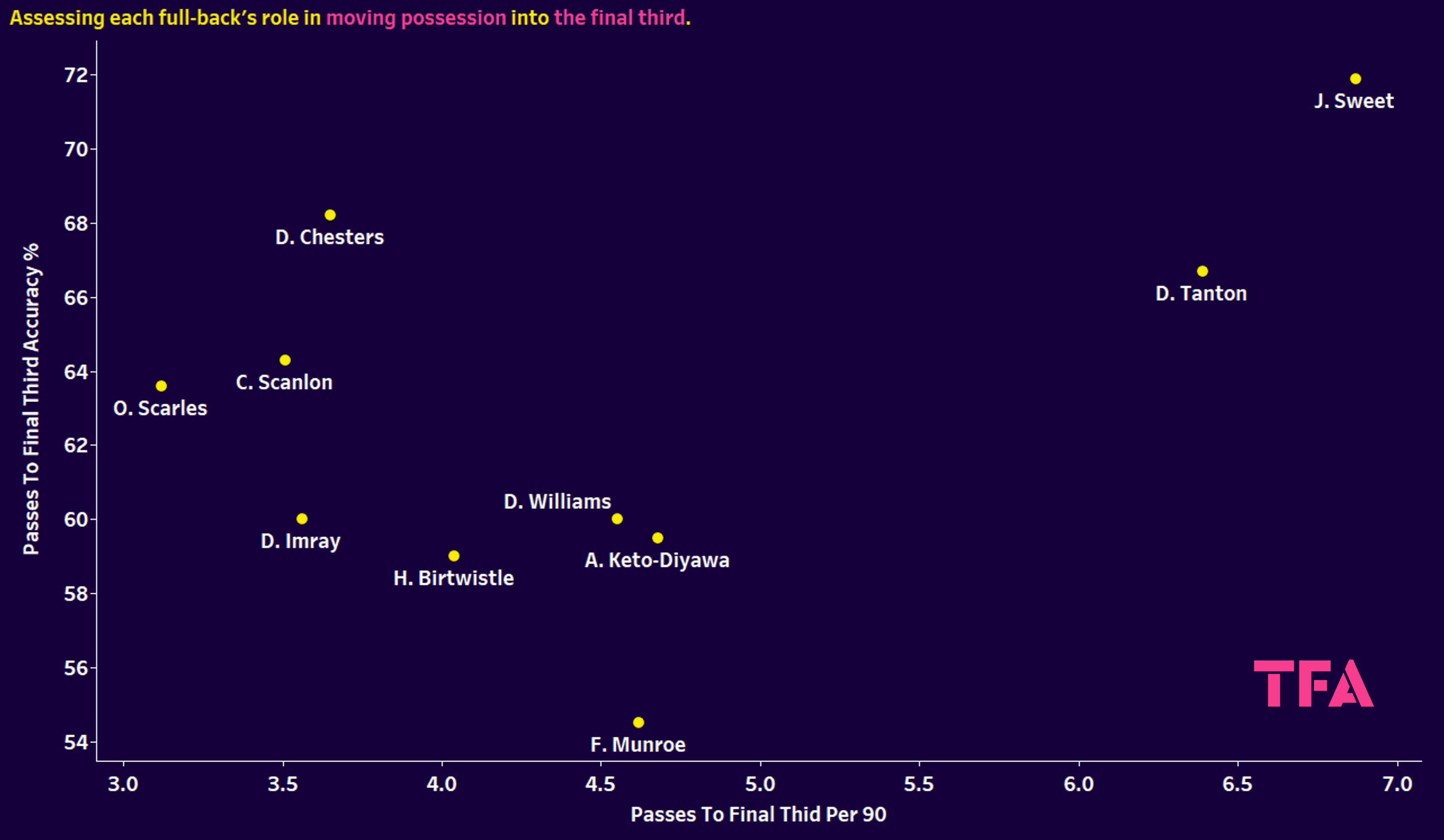
Full-backs and wing-backs are often highly important in the early build-up phases of an attack, usually vital in moving the ball forward into more advanced zones. To judge the players’ performance in this area, we’ll look at their engagement and accuracy with passes into the final third.
Straight away, one player jumps out of the screen — Arsenal right-back James Sweet, who averages 6.87 passes to the final third with an accuracy rate of 71.9% – leading the group in both metrics. While this could be down to an apparent technical ability and attacking hunger, it is essential to note that Sweet also plays as a winger from time to time, which can increase his attacking involvement. Tanton also offers similar numbers.
West Ham right-back Daniel Chesters offers one of the lower engagement rates of the group but does offer a high accuracy rate, indicating a good level of reliability when tasked with moving the ball forward.
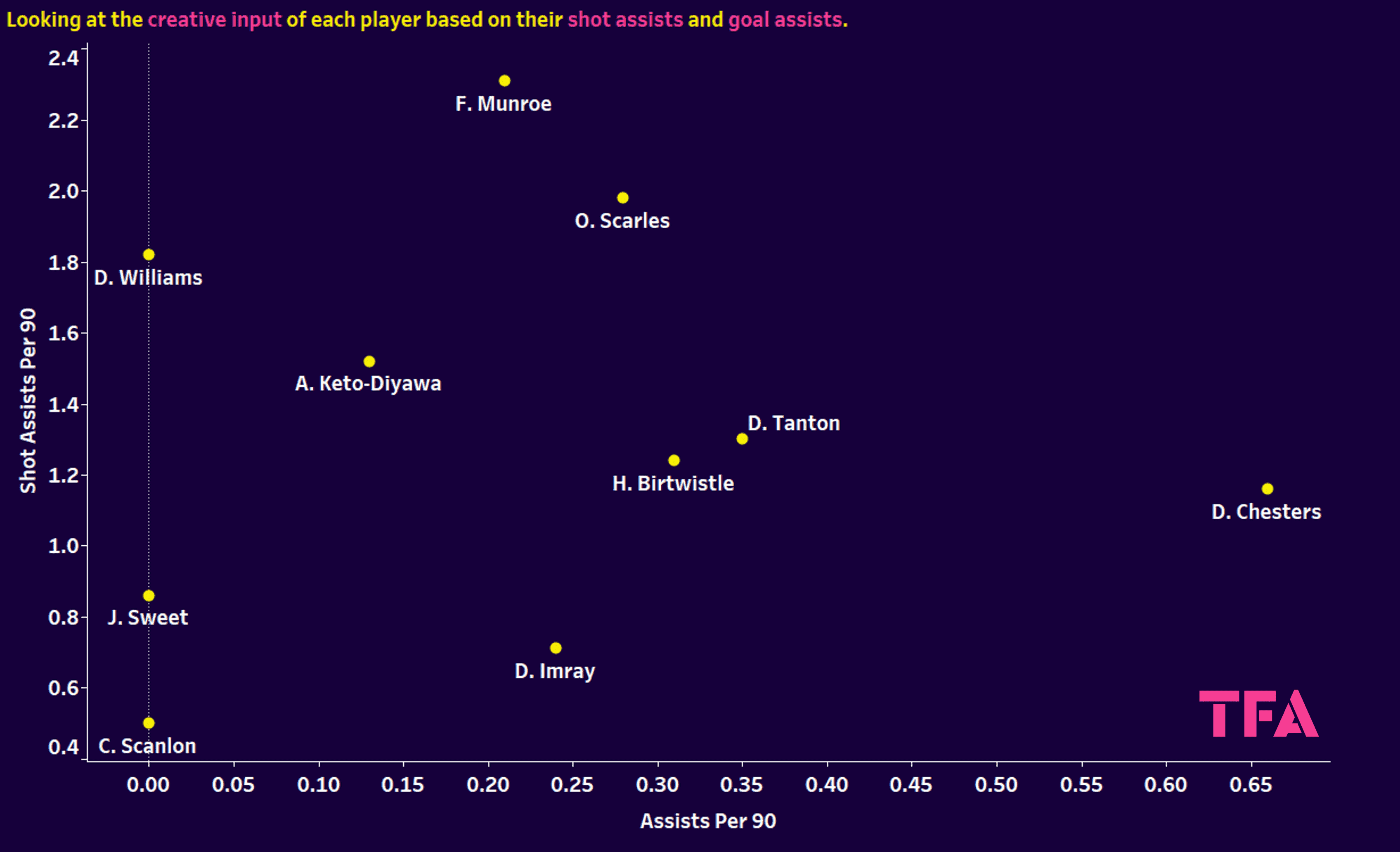
Creative full-backs are becoming increasingly common in the game, with setting up chances on goals being a key attribute. Here, we look at how each player fairs in assists and shot assists to see which full-backs offer quality in the latter moments of an attack.
Chester gets another mention due to his exceptional assist rate, averaging 0.66 per 90 while setting up 1.16 shots per 90. If he can (if he hasn’t already) pinpoint why he is so effective in creating chances, he could be a real asset, at least within the EFL.
Other players such as Williams, Munroe, and Scarles all offer excellent averages for shot assists, which suggests they are can be consistently effective in dangerous moments in attacking possession.
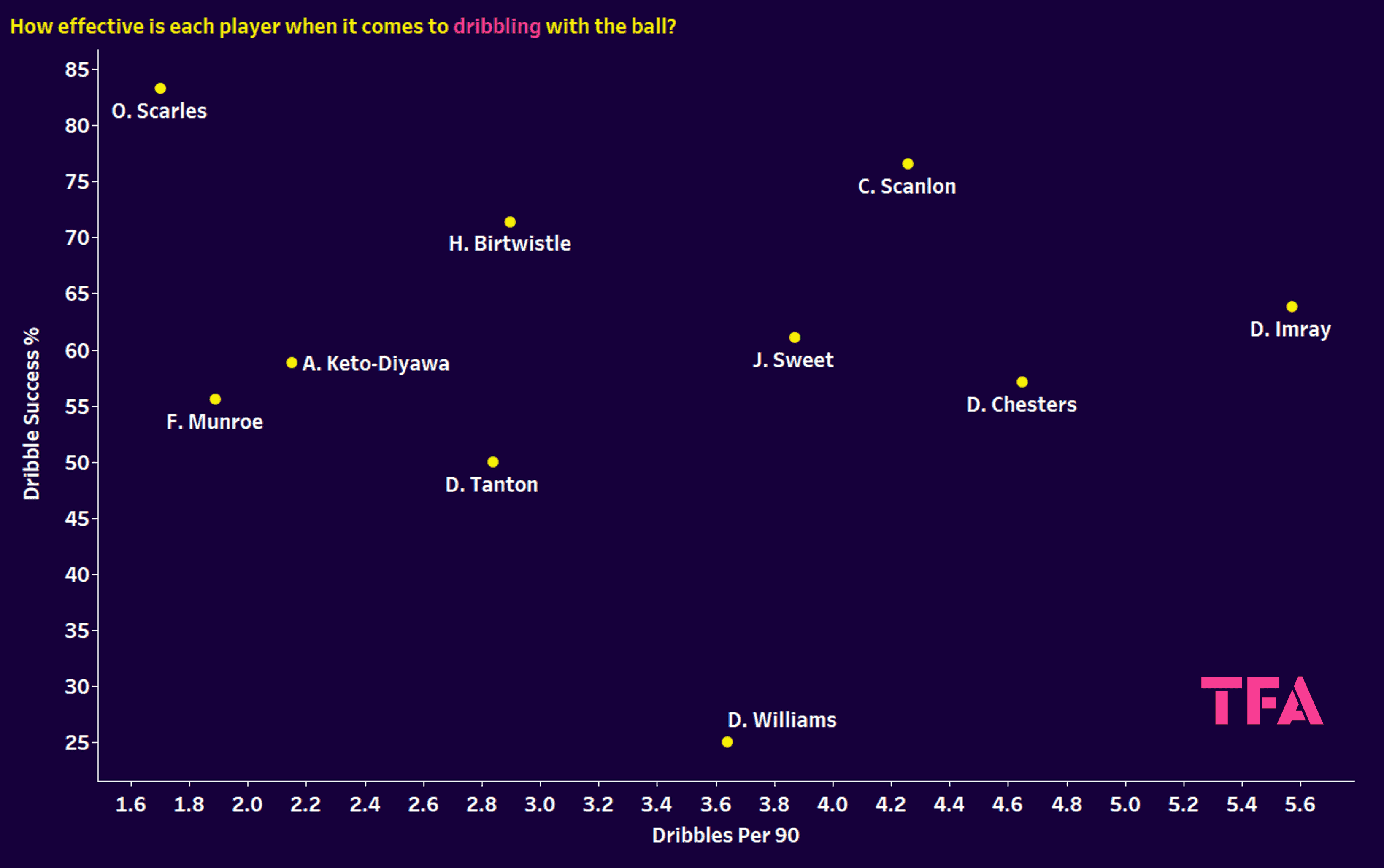
Carrying the ball is a specialist skill – if you want a player to dribble with a high ability to beat opponents consistently, and full-backs quickly carrying the ball upfield can be a very good attacking move.
Crystal Palace right-back Danny Imray’s statistics make it fair to say that he possesses good technical talent that he is able to apply consistently, evidenced by a high engagement rate of 5.57 dribbles per 90 paired with a very strong success rate of 63.8%. Liverpool left-back Callum Scanlon offers a slightly lower engagement with 4.26 dribbles per 90, which is still indicative of a highly attacking full-back – his success rate is what stands out (76.5%), which bodes well for him in terms of meeting that requirement for being a Liverpool full-back in a high-intensity team.

This final graph ties in somewhat with the previous graph, but instead of measuring all dribbles, it looks at the number of progressive runs per 90 – a continuous spell of control on the ball which takes the player significantly closer to goa, different to, say, a 2-3 yard dribble.
It’s no surprise that Scanlon (3.01) impresses again here – it appears he has a strong talent for carrying the ball. Other strong contenders include Chesters (2.82) and Imray (2.85) – all three of these names faired well in the previous graph, too.
Conclusion
While we have had many star names produced from former EPL2 players in recent years, it is still challenging for young players to break into the team at such a high level. Often, the only chance they get is when there’s an injury crisis in their position or toward the end of the season when a club feels they have little left to play for in terms of season objectives.
There are a few names here who could make that step up directly to their first team in the next year or so, based on the data provided in this analysis – Callum Scanlon could be a player we see line up for Klopp as the German manager has a reputation for giving chances to young players. Elsewhere, Fulham’s De Fougerolles has displayed some defensive grit, so he is a possible first-team candidate should the circumstances align for him. Of course, there could be others in the same frame.
Another option, outside of making the direct step up U21s/U18s to the first team, is going out on loan to an EFL club like James Trafford did last season. Furthermore, many EPL U21 sides compete in the EFL Trophy, which, despite the way the competition and its integrity divides EFL fans, can be a good way for those U21 players to get experience against first-team professionals. Whitworth has played twice for Palace’s U21s in the EFL trophy, so he has been exposed to football against professional sides, which could be suitable for his development in the long term. It could also place on the radar of EFL clubs looking to bring in a young keeper on loan. That is just one example – several players have played in the EFL Trophy for their respective U21 squads this season.

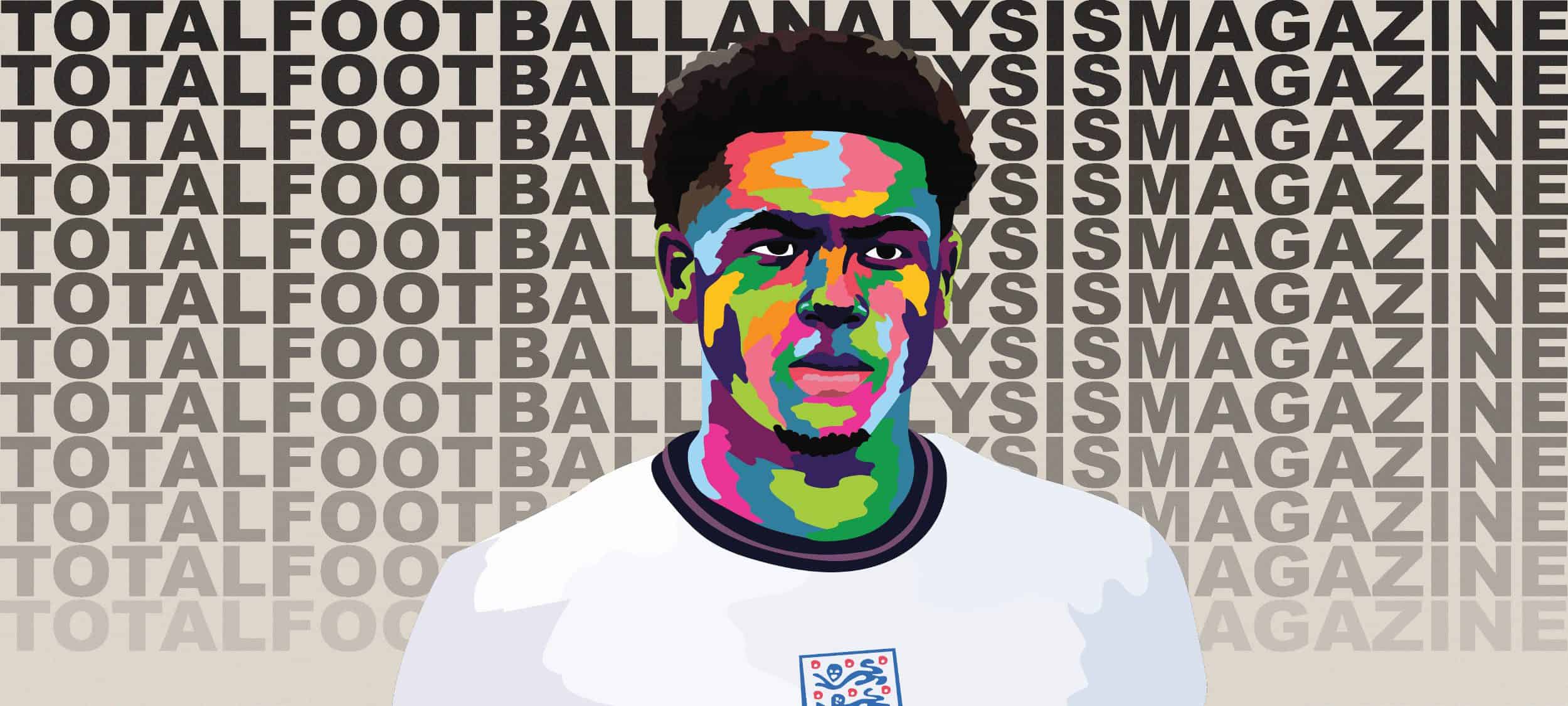




Comments